

News
August 2024
Additively manufactured high strength aluminium alloys A205 and AlSi10Mg treated by ECO ceramic demonstrated remarkable properties
In recent years, additive manufacturing of Aluminium alloys has achieved remarkable developments, allowing for the replacement of complex casted components in numerous industrial fields including aerospace and automotive. The main issue affecting these alloys during operation at high temperatures and in critical environments is poor corrosion and wear resistance. Cambridge Nanolitic in collaboration with TWI and Birmingham University presented and characterized a robust protective coating using proprietary electrochemical oxidation (ECO) process (which is also called soft sparking Plasma Electrolytic Oxidation), on two high-strength Al alloys, AlSi10Mg and A205, processed by Laser-Powder Bed Fusion (L-PBF)
The results highlighted a remarkable increase in the tribological performance, with a very low wear rate of 0.11 mm3/m and enhanced corrosion performance.
The results of the project have been presented in Surface & Coatings Technology 489 (2024) 131122: “Plasma electrolytic oxidation (PEO) as surface treatment for high strength Al alloys produced by L-PBF: Microstructure, performance, and effect of substrate surface roughness". https://www.sciencedirect.com/science/article/pii/S0257897224007539?via%3Dihub


June 2024
High strength bonding of ECO ceramic coated aluminium
Bonding to a ceramic coated alumnium surface or joining ceramic coated surfaces becomes a technical challenge if your joint is to operate at temperatures up-to 2000 C.
A collaborative effort of Cambridge Nanolitic (UK), Politecnico di Torino (Italy) and Università di Trento (Italy) resulted in a development of efficient bonding solution based on silica preceramic polymer. The incorporation of a passive filler, specifically nanometric amorphous silica, enabled effective control over the critical aspects of the cross-linking process, resulting in significant enhancements in both joint morphology and mechanical strength. This advancement transitioned the joint to a much denser and more compact structure, capable of achieving an average tensile strength of approximately 7 MPa, which is four times greater than that achieved using the pure polymers.
The bending stress at which the first crack appeared on the coating was notably 570 MPa, further extending the potential applications of ECO coating to environments that require substantial mechanical resistance.
The results have been presented in a paper published in Coatings 2024, 14, 757. https://doi.org/10.3390/coatings14060757

December 2023
Launch of International Collaboration Project on Development of innovative Hydrogen Embrittlement Protection Coating (HEPCO)
Development of innovative Hydrogen Embrittlement Protection Coating (HEPCO) is a collaborative project between UK and German material science SMEs and research institutions supported by Innovate UK and Zentralen Innovationsprogramms Mittelstand (ZIM) that just started on December 1, 2023. The project is aimed at developing a disruptive enabling technology to prevent failures of metal components caused by Hydrogen Embrittlement (HE) which appears a limiting factor for Hydrogen Economy growth. The project is based on an innovative approach of building Hydrogen Permeation Barrier (HBP) coatings on metals by a synergetic combination of original electrochemical-oxidation (ECO) technology of forming nanoceramic layers developed by Cambridge Nanolitic Ltd (CNL) with a novel vacuum coating/sealing technology of a German partner NTTF. The Max-Planck-Institut für Eisenforschung (Germany) will conduct basic research performing advanced microstructure and localized mechanical characterisation of coatings and HE of underlying metal. The hydrogen permeation and embrittlement will be measured by Cranfield University (UK) at their unique HE direct measurement facilities.

October 2023
Cambridge Nanolitic extends R&D collaboration with leading Universities
A growing number of scientific papers on Plasma Electrolytic Oxidation (PEO) reflect a genuine interest in that process by the academic community and industries. However, sometimes scientific results have limited relevance to industrial PEO processes and coatings. It is explained by the scale difference between laboratory PEO set ups and industrial coating units. Modern PEO coating machinery operates with treatment tanks of large volumes from hundreds of litres up to several tons. They are equipped with electrolyte temperature and circulation flow controls. Bipolar pulsed power supplies enable multi-step programming of electrical parameters. Many of those features are not available at the research laboratories. Even geometric parameters (often ignored by the researchers) like a ratio between coated part surface area and the cathode surface area can greatly differ. Cambridge Nanolitic respecting their university roots is trying to help researchers involved in PEO development and characterization with treatment of their samples at company’s advanced industrial machinery. We are proud to name some of those who recently examined our coatings. They are Universities of Manchester, Birmingham, Sheffield, Portsmouth, Bologna, Naples, Polytechnics of Milan and Turin. We are inviting university researchers to contact us with their sample requests with a promise that reasonable size batches will be treated for free.
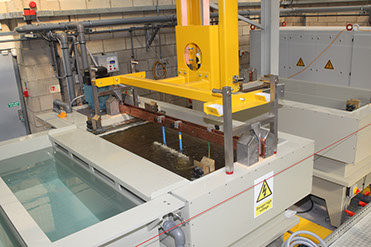
July 2023
Cambridge Nanolitic provides unique surface treatment equipment to the University of Manchester
A unique electrochemical surface treatment unit has been installed and commissioned by Cambridge Nanolitic Ltd and ICS Systems Ltd at Henry Royce Institute in Manchester. Bespoke digitally-controlled bipolar pulse system provides a wide range of process parameters enabling development of innovative surfacing processes.
The team at Plasma Electrolysis Research Laboratory in Manchester University led by Dr Yerokhin highly appraised capabilities of the new machinery for bridging fundamental and applied research in plasma assisted coatings.
Collaboration between the teams in Manchester and Cambridge Nanolitic has deep roots and long track record of successful innovation in surface engineering.
On the photo: after a successful launch (from left to right) Dr Nicolas Laugel, Dr Aleksey Rogov, Dr Pavel Shashkov, Sergey Usov, Ian Stevenson, Dr Aleksey Yerokhin.
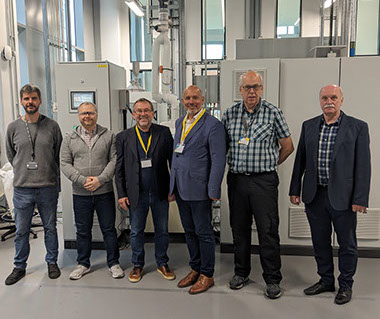
January 2023
Cambridge Nanolitic expands licensing geography
Cambridge Nanolitic, UK based developer and patent holder for the innovative ECO surfacing technology, advanced version of Plasma Electrolytic Oxidation (PEO), having success in licensing and transfer of their technology in Europe and USA signed a representative deal with an established Japanese technology consultancy company, Neptune Group (https://lnkd.in/eKYR5DAR) to promote ECO technology in Japan. ECO (electro chemical oxidation) technology is an advancement of PEO process that provides ceramic coatings with enhanced hardness, wear- and corrosion resistance, dielectric strength and plasma resistance.

January 2023
Comparison between ECO (Electro Chemical Oxidation) and PEO (Plasma Electrolytic Oxidation) technologies published
Comparison between two advanced surface treatment processes for Aluminium has been presented in a recent paper “Phase transitions in alumina films during post-sparking anodising of Al alloys” downloadable at: https://bit.ly/3XrTR0Y.
Traditional Plasma Electrolytic Oxidation (PEO) treatment has been compared with a novel Electro-Chemical Oxidation (ECO) technology that aims to avoid sparking/arcing phenomena and provide surface layers with superior mechanical properties. Data on industrial applications of ECO technology can be found at www.nanolitic.com.
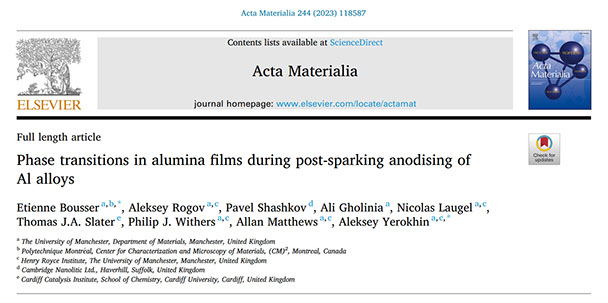
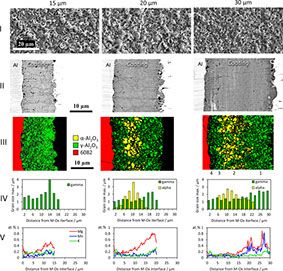
December 2022
ECO (Electro Chemical Oxidation) for Additive Manufacturing presented
Additively Manufactured (AM) lightweight components require enhancement of their surface properties such as wear and corrosion resistance for most application. AM techniques provides aluminium with peculiar compositions and morphology which causes difficulties in using traditional surface treatments such as anodising or galvanic plating. ECO (Electro Chemical Oxidation) technology provided by Cambridge Nanolitic (www.nanolitic.com) enabled to significantly improve surface properties of AM aluminium.
Microstructural and tribological properties of ECO ceramic coating of additively manufactured Aluminium alloy A357 have been presented by a University of Bologna group headed by Prof Carla Martini in a recent publication Anodizing by Electrochemical Oxidation (ECO) of the Laser Powder Bed Fusion‑processed A357 aluminium alloy: microstructural characterization and dry sliding behaviour http://bit.ly/3Hl7Yzu.

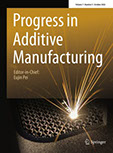
April 2022
Hydrogen embrittlement should be taken seriously
Hydrogen is believed to be a fuel of the future providing carbon neutral energy to industries, households and particularly transport vehicles. Major technical problem for its transportation, storage, and handling is hydrogen-induced cracking, embrittlement of a metal. That can cause catastrophic failures of metal components that are in contact with H2. Today the problem of Hydrogen Embrittlement (HE) is addressed by selection of metals that are less prone to HE such as several aluminium alloys and even coating of steel parts by aluminium. An alternative way of preventing HE can be a coating of metal with barrier layers that do not allow hydrogen to attack metal. Cambridge Nanolitic (www.nanolitic.com) plan to apply their original nanoceramic technology and 15 years of experience in metal surfacing to develop a coating for prevention of hydrogen embrittlement. Company is open for collaboration.
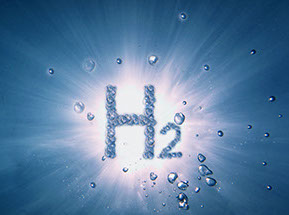
November 2020
University of Bologna (UNIBO) scientists identified best surface treatment for Magnesium.
After years of comparative studies UNIBO researchers headed by Prof Carla Martini identified that Electrochemical Surface Oxidation (ECO) treatment of Cambridge Nanolitic (www.nanolitic.com) provides most compact oxide ceramic layer with wear resistance an order of magnitude higher than next best PEO surface layer (block-on-ring dry sliding tests against 100Cr6 bearing steel).
Friction Coefficient of the ECO surface was about 40% lower.
Remarkably, no decrease of fatigue strength was observed for ECO treated samples by comparison to the untreated alloy with the same surface roughness (4-point rotating bending fatigue, ISO1147). Detailed results of the study to be published in 2021.

March 2020
Quantum leap in textile machinery
Modern textile machinery is facing an ever-growing need for (1) increase of productivity and (2) dealing with new highly abrasive materials like synthetic fibres.
Increase of manufacturing speed requires use of much lighter materials such as Aluminium or even Magnesium instead of heavy steel and ceramic for moving parts of textile machinery. Light metal parts have lower inertia and enable to move components much faster, increasing productivity and reducing energy consumption. Use of light metals is limited by their low wear resistance, particularly in case of abrasive yearn, such as denim or synthetic fibres. Modern surface treatments for light metals used for textile components such as plasma sprayed ceramic, hard anodising, chrome and nickel coatings are known for decades and reached their performance limits.
A quantum leap in providing light metal components with record high wear resistance was secured by introduction of novel ECO-ceramic coating which was immediately appreciated by a number of leading European manufacturers. Within a short time, ECO-ceramic became a coating of choice for a range of critical components in textile machinery such as shuttles, grippers, rollers, fingers, disks, etc.
Fine nanoceramic coating surface appeared to be yarn friendly and exceptionally wear resistant, well above traditional surface treatments. Environmentally safe innovative electrolytic process enables to apply dense, highly adherent ceramic layer on components of practically any shape. Cambridge Nanolitic (www.nanolitic.com) the developer and supplier of ECO-ceramic coating is providing textile manufacturers with unique possibilities to design highly productive versatile machinery and light durable components.

October 2019

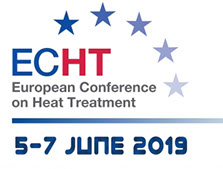
ECO-ceramic surfacing superior to Hard Anodising and PEO
Comparison of tribological properties of ECO-ceramic coating applied by Electro Chemical Oxidation (ECO) vs Hard Anodizing (HA) and Plasma Electrolytic Oxidation (PEO) was presented by Prof Carla Martini (https://www.unibo.it/sitoweb/carla.martini/en), University of Bologna at ECHT 2019 Surface Engineering Conference (http://www.aimnet.it/echt2019.htm).
ECO-ceramic coating produced by Cambridge Nanolitic Limited (http://www.nanolitic.com) on Aluminium Alloy 6082 demonstrated at least 50% higher scratch and wear resistance in progressive load scratch test and dry sliding wear test.
April 2019
Wear resistant coating for special alloys.
Aluminium-Lithium Alloy 2099 is a material of choice for motorsport and aerospace industries due to its unique combination of strength and lightness. Surface treatment of this alloy such as anodising or PEO is complex due to presence of Cu, Li and Zn in it.
Cambridge Nanolitic scientists developed an innovative electro-chemical oxidation (ECO) treatment for Al-Li 2099.
ECO process enabled to build 5 - 60 micron thick oxide ceramic layers on that alloy to provide it best in class wear and corrosion resistance.

October 2018
Tribological properties of nanoceramic coating compared to conventional hard anodizing and plasma electrolytic oxidation (PEO).
This study is focused on comparison of the microstructural features and dry sliding behaviour of the oxide layers grown on the same aluminium alloys under different surface treatment conditions, comparing nanoceramic coating with conventional anti-wear surface treatments such as hard anodizing with PEO.
In collaboration with University of Bologna Dept. of Civil, Chemical, Environmental and Materials Engineering (DICAM) and Department of Industrial Engineering (DIN), Alma Mater Studiorum, Bologna, Italy.
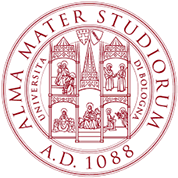
February 2017
Durable Plasma Reactor Electrodes with Nanoceramic Coating.
In collaboration with University of Sheffield. Supported by Innovate UK.
Plasma processing is widespread for synthesis of high performance materials. For most common types of plasma reactors the electrodes must be robust and also of high tolerance of the uniformity of thickness of ceramic coating, particularly for multiplexed microreactors. The project explores the application of coating developed by Cambridge Nanolitic to achieve the necessary level of tolerance and durability, and will test the plasma reactor fidelity and performance on an exemplar application to produce ozone-rich microbubbles for “green” laundry cleaning and water sterilisation.
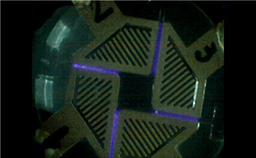
Electrodes of plasma reactor with Nanoceramic coating in operation
June 2016
Multifunctional nanoceramic surfacing for Titanium implants.
In collaboration with University of Manchester. Supported by Innovate UK.
Project explores the technical feasibility of a novel nanoceramic surfacing for titanium implants developed by Cambridge Nanolitic to enhance their biocompatibility and osseointegration.
Cambridge Nanolitic provides Ti implants with nanoceramic surface to effectively combine the best features of metal implants such as high mechanical strength and formability with high biocompatibility, corrosion resistance and aesthetics of ceramics.
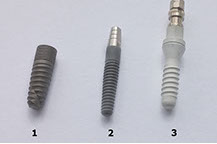
Titanium Dental implants with different finishes: 1. Etched Titanium surface; 2. TiUnite finish, Nobel Biocare; 3. Cambridge Nanolitic White.
November 2011
Cambridge Nanolitic spins off Cambridge Nanotherm Limited (www.camnano.com) focused exclusively on electronic applications of nanoceramic coating.
Electronic substrates with nanoceramic dielectric insulation have a unique combination of high dielectric strength and thermal conductivity.
LED industry leaders expressed interest to Nanotherm TM substrates for solid state lighting application.
Investment for a spin off company was secured from a London based VC fund. Manufacturing plant for producing novel electronic substrates is built in Haverhill, Suffolk, UK

May 2010
Nanostructured surface with self-assembled Nanocomposites
Cambridge Nanolitic developed an original technology based on controlled processes of self-assembly and self-organization of colloidal nano-components during the formation of their complexes with polyfunctional ligands in a bulk liquid phase for functionalisation of nanoceramic surfaces.

